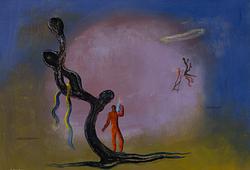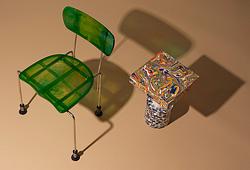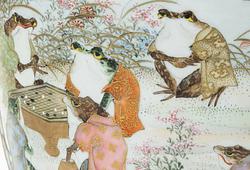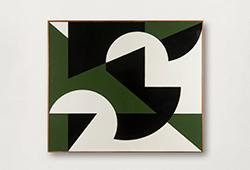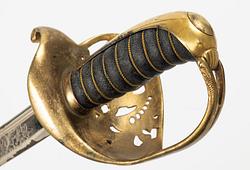UTAGAWA KUNISADA (1786-1864), colour woodblock print. Japan, 1840's. 'Yokozuna Shiranui'.
Depicting the sumo wrestler Yokozuna Shiranui with traditional apron and ropes, with the wrestlers Takaneyama to the left and Kurogumo to the right. Measurements 24,5x18 cm, measeurement with passepartout 42x55 cm. Unframed.
Minor wear to edges and dis-coloration. Soft handling creases. Colors possibly slightly faded.
Alkuperä - Provenienssi
From the Collection of Göran Flyxe.
Näyttelyt
Exhibited at the Far Eastern Museum, Stockholm. “Sumo, Ritual and Art” - Japanese woodblock prints from the Göran Flyxes Collection; 29/10 2016-29/1 2017, Tikotin Museum of Japanese Art, Haifa, Spring 1997, Grafiska Galleriet, Stockholm 1 – 19/12 1973, Krognoshuset, Lund 14-30/1 1974, Norrköping Museum, Norrköping 9/6-28/7 1974, Kalmar Museum, Kalmar nov 1974, Sweden Center Bldg, Tokyo 31/5-1/6 1975, Röhsska Museet, Göteborg 9/12-23/1 1978, Galleri Asthley, Skinnskatteberg 5/6-18/7 1993, Östasiatiska Museet, Stockholm 24/12 1993-14/3 1994.
Kirjallisuus
Depicted in the exhibition catalogue "Sumo - Heavyweight Art", woodblock color prints form the collection of Göran Flyxe, Stockholm. Page 10.
Muut tiedot
Japanese Sumo Wrestling is one of the oldest martial arts in Japan. Sumo wrestlers were a favorite subject on Japanese woodblock prints.
Sumo has its roots in the shinto religion. The matches were dedicated to the gods in prayers for a good harvest. The oldest written records date back to the 8th century. But it is probably more than 1500 years old.
Sumo prints from the 18th and 19th century prove the popularity of the sport in the past.




